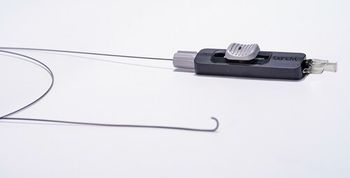
Black female physicians face challenges just doing their jobs
When Melanie Gordon, MD, FACP, walks into a patient’s room at the John H. Stroger Hospital of Cook County in Chicago, she’s frequently misidentified as a nurse, a dietician or someone else.
When Melanie Gordon, MD, FACP, walks into a patient’s room at the John H. Stroger Hospital of Cook County in Chicago, she’s frequently misidentified as a nurse, a dietician or someone else.
Hot topic:
“I once had a patient who kept talking to me about Maryland,” says Gordon, director of student education for the department of internal medicine and assistant professor at Rush Medical College. “I finally said ‘Why do you keep asking me about Maryland. I’m not from Maryland.’ He said ‘Doesn’t your ID say MD for Maryland?’ He’s in his hospital bed, and he sees me come in with my white coat on, and he could not fathom that I am a doctor.”
Melanie Gordon, MD, FACP
Gordon is African American
“I don’t know if it’s because we’re women or what, but we definitely have to get people to overlook their bias to even do our job,” Gordon says.
The bias might change if more African American women were physicians, Gordon says. Gordon’s story is recounted in Crystal Emery’s new book:
Following the production of the movie and the book, Gordon and other black female physicians around the country have shared both the book and the movie with young girls and their parents at screenings and diversity events, to encourage them to pursue careers in medicine. These physicians who are involved in the project support Emery’s goal to increase the amount of all African American physicians to 7%, but especially to enlarge the numbers of female African American doctors, by 2025.
Rashele Yarborough, MD, Ph.D. was featured in the film’s opening sequence about medical students receiving their residency assignments on Match Day.
Further reading:
“Since then, I’ve finished residency and started in my practice,” says Yarborough, a family practice physician at the Meriden Family Practice in Meriden, Connecticut. “One thing I wasn’t expecting from being involved in this project is to meet so many of the other women in the film and book at screenings and book signings. Just to meet others within such a small percentage has been wonderful, to have this connection and camaraderie.”
Both Yarborough and Gordon had very supportive parents and advisers.
“One of the most powerful ways to encourage our next generations into the field of medicine, black, brown or otherwise, is to provide mentors for them to not only look up to, but also to be in contact with them so they can ask their questions,” Yarborough says, pointing out that some hospitals and clinics offer Medical Explorer programs, which allow students to mingle with and meet medical professionals.
Further reading:
“One of the reasons I wanted to be a part of this is to get the chance to communicate with girls in some of the areas where I came from,” Gordon says, adding that after the book’s publishing, she’s had the chance to to speak with younger girls about the possibilities of becoming a physician..
“A lot of them don’t even think it’s a possibility to become a doctor,” she continued. “They would tell me things like ‘My mom says I should be more realistic, that I should be a nurse.’ These girls don’t see anybody who looks like them in these positions, and they don’t have anybody encouraging them. You can’t be what you can’t see. The glass ceiling was in their homes.”
A lot of girls say their career aspiration is to become a nurse because they don’t believe that becoming a doctor is an attainable goal, Yarborough says.
In sharing her journey, Gordon says Emery really encouraged her to open up about her challenges and how she overcame them. “It’s about how you deal with failure, how you teach them resiliency,” Gordon says.
By the time Gordon was in eighth grade, she knew she liked science so she was thinking of becoming a teacher. But after volunteering at Rush Medical School and working in a research laboratory at the University of Illinois-Chicago, Gordon met physicians and scientists who expanded her horizons and helped her navigate the journey to medical school, involving her in their research and even naming her on their papers and projects.
“Allowing students at the high school and college level to shadow you and to serve as mentors makes a difference,” Gordon says. “It’s important to be willing to write letters of recommendation and not just generic ones. Those are the things we can do.”
Related:
“It’s important for my colleagues to pay attention to young people who may aspire to medical careers or who may not yet realize that they aspire to them, that we remain positive and encouraging,” Yarborough says.
Yarborough became first interested in a possible career in medicine when she was a young girl, and she received a lot of encouragement from her pediatric allergist, who treated her severe allergies every week or every other week from the time she was four until she was 16. “Just his demeanor and the care he offered was such that I found myself looking forward to my appointments,” Yarborough says. “That was a really special connection, and then throughout high school and college, I volunteered at hospitals and interacted with physicians. I had many awesome mentors along the way.”
Mentors helped guide both Yarborough and Gordon through the process. “So much of the journey to becoming a physician, for many, it’s still this black box,” Yarborough says. “People need to know the steps along in the process, the things you need to do, the things you need to know about, even college applications. The more that we can make these steps known, the easier it is for people to decide if this is something they see themselves being able to do.”
Hot topic:
Gordon also said that it is important to promote women and especially women of color. That influenced her decision to practice where she practices – because women are in leadership positions at her hospital. “When medical students and residents look at a program and see doctors who look like them, they feel more comfortable applying to those positions,” Gordon says.
Yarborough and Gordon encourage their colleagues at medical schools and hospitals to screen the film and to share books with students.
“Recognizing the value of diversity in our field is incredibly important,” Yarborough says. “It’s important for us to remain positive and encouraging (to young people). Some of our patients may be our colleagues in the future.”
Newsletter
Stay informed and empowered with Medical Economics enewsletter, delivering expert insights, financial strategies, practice management tips and technology trends — tailored for today’s physicians.















